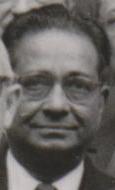K. S. Krishnan facts for kids
Quick facts for kids
Kariamanikkam Srinivasa Krishnan
|
|
|---|---|

K. S. Krishnan 1952 in London
|
|
| Born | 4 December 1898 Watrap, Tamil Nadu, India
|
| Died | 14 June 1961 (aged 62) |
| Nationality | Indian |
| Alma mater | The American College in Madurai Madras Christian College University of Madras Calcutta University |
| Known for | Raman effect Crystal Magnetism Magneto Chemistry Technique for measuring Magnetic anisotropy of magnetic crystals |
| Awards |
|
| Scientific career | |
| Fields | Physics |
| Institutions | Madras Christian College Indian Association for the Cultivation of Science Dacca University Allahabad University National Physical Laboratory of India |
| Academic advisors | CV Raman |
Sir Kariamanikkam Srinivasa Krishnan (born December 4, 1898 – died June 14, 1961) was a famous Indian physicist. He is often called K. S. Krishnan or KSK. He helped discover something important called Raman scattering. His teacher, C. V. Raman, won the 1930 Nobel Prize in Physics for this discovery.
Contents
Early Life and Education
K. S. Krishnan was born on December 4, 1898, in Watrap, a town in Tamil Nadu, India. His father was a farmer who also knew a lot about Tamil literature.
Krishnan went to school in Watrap. Later, he studied at The American College in Madurai and the Madras Christian College. After getting his degree in Physics, he worked as a demonstrator in chemistry.
Discovering the Raman Effect
In 1920, Krishnan started working with Professor C.V. Raman in Kolkata. They studied how light scatters, or spreads out, in different liquids. This work was very important.
Krishnan played a big part in discovering the Raman effect. This effect explains how light changes when it passes through a material. It helped scientists understand more about the structure of molecules.
Research on Crystal Magnetism
In 1928, Krishnan became a Reader (a type of professor) at Dacca University in what is now Bangladesh. There, he began to study the magnetic properties of crystals. He wanted to see how a crystal's structure affected its magnetism.
Krishnan and other scientists developed a new way to measure the magnetic properties of crystals very precisely. Their findings were published in 1933. This research helped us understand how tiny crystals behave magnetically.
In 1933, he returned to Kolkata. He continued his research on crystal magnetism. His work with his colleague, Santilal Banerjee, led to the "Krishnan Banerjee method." This is a special way to measure the magnetic strength of small crystals.
Awards and Leadership
K. S. Krishnan was recognized for his important scientific work. In 1940, he was chosen as a Fellow of the Royal Society (FRS). This is a very high honor for scientists.
In 1942, he became a professor at Allahabad University. He focused on the physics of solid materials, especially metals.
He received many awards for his contributions to science:
- In 1946, he was made a Knight Bachelor, which means he could use the title "Sir."
- In 1954, the Indian government gave him the Padma Bhushan award.
- In 1958, he was the very first person to receive the prestigious Bhatnagar Award.
On January 4, 1947, Krishnan became the first director of the National Physical Laboratory of India. This was one of the first national science labs set up in India.
See also
- Raman scattering
- Magnetic anisotropy


